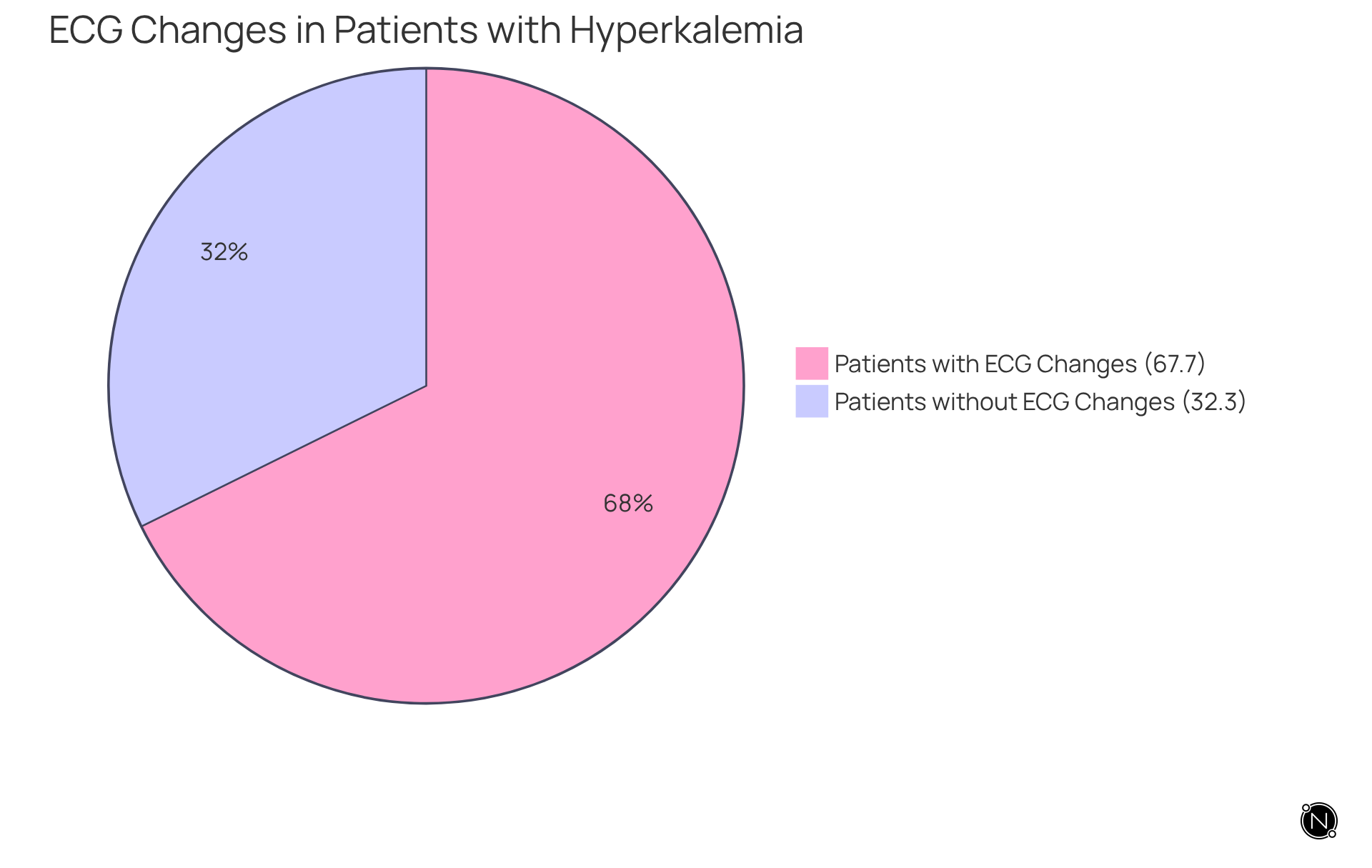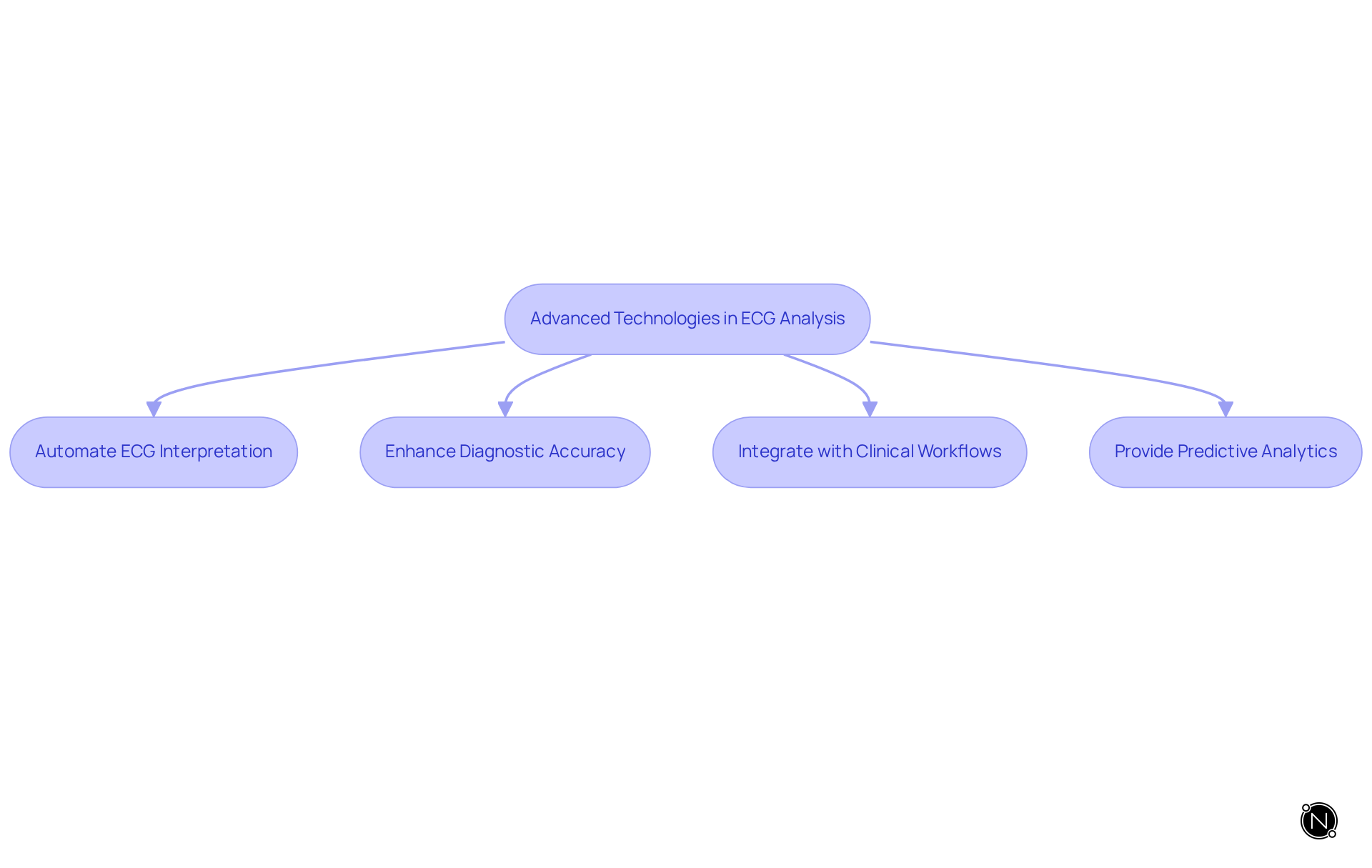Overview
This article highlights the importance of mastering ECG techniques for the identification of hyperkalemia. Elevated potassium levels can precipitate critical cardiac changes and arrhythmias, making this knowledge essential for healthcare professionals. The article details specific ECG alterations, such as:
- Peaked T waves
- Widened QRS complexes
These alterations are vital for timely diagnosis and intervention. By understanding these changes, practitioners can significantly enhance patient outcomes in emergency settings.
Introduction
Hyperkalemia poses a silent yet significant threat to cardiac health, as elevated potassium levels can lead to life-threatening arrhythmias. It is essential for healthcare professionals to understand the complex relationship between hyperkalemia and electrocardiogram (ECG) changes. Timely identification of these changes can be critical, potentially making the difference between life and death. However, accurately interpreting ECG findings presents several challenges. Advanced technologies have the potential to transform the monitoring and management of this critical condition, offering new solutions to enhance patient outcomes.
Define Hyperkalemia and Its Cardiac Implications
Hyperkalemia is defined as a serum concentration exceeding 5.5 mmol/L, characterized by two elevated serum values from inpatient or outpatient settings. An ECG for hyperkalemia is essential, as elevated potassium levels can severely disrupt the heart's electrical activity, leading to potentially life-threatening arrhythmias. This condition poses significant risks, as abnormal heart rhythms can culminate in cardiac arrest. Recent studies indicate that high potassium levels are associated with increased myocardial excitability and conduction disturbances, which can drastically affect patient outcomes.
For example, the yearly occurrence rate of elevated potassium levels at ≥5.0 mmol/L is 4.24 events per 100 person-years. In individuals with chronic kidney disease (CKD), rates can reach 19.1 events per 100 person-years among those with severe renal impairment. Clinicians must maintain a high level of vigilance in monitoring potassium levels, particularly in patients with pre-existing cardiac conditions or those undergoing treatments that influence potassium metabolism.
The importance of this monitoring is highlighted by results showing that 67.7% of patients with displayed changes, mainly peaked T waves, indicative of high potassium levels' effect on heart rhythm. As cardiologists emphasize, using an ECG for hyperkalemia is essential for the prompt identification and treatment of elevated potassium levels to prevent negative cardiac incidents and enhance patient outcomes.

Identify Key ECG Changes in Hyperkalemia
The ECG alterations associated with elevated electrolyte levels develop as concentrations increase, highlighting the importance of obtaining an ECG for hyperkalemia and necessitating careful monitoring by healthcare providers. Initially, clinicians may observe peaked T waves, often the first indication of rising electrolyte levels. As hyperkalemia advances, the following changes may be observed:
- Prolonged PR interval: This indicates delayed conduction through the atrioventricular node, typically extending beyond 200 milliseconds.
- Widened QRS complex: Characterized by a duration greater than 120 milliseconds, this reflects impaired ventricular conduction and poses a risk for serious arrhythmias, generally occurring at potassium levels ≥ 6.5 mEq/L.
- Loss of P components: The absence of P components signifies severely elevated potassium levels, indicating significant conduction disturbances that can complicate diagnosis.
- Sine pattern: This critical sign of impending cardiac arrest emerges when the QRS and T patterns merge, which may be misinterpreted as idioventricular rhythm or ventricular tachycardia, complicating diagnosis and underscoring the need for prompt clinical intervention.
Recognizing these ECG changes related to ECG for hyperkalemia is essential for timely action, as they can significantly influence patient outcomes in emergency situations. For example, a case involving a 51-year-old woman with high potassium levels presented junctional tachycardia, a wide QRS, and peaked T waves, necessitating immediate treatment to prevent life-threatening complications. It is also crucial to understand that symptoms of elevated potassium do not consistently manifest with specific serum potassium levels, which highlights the importance of continuous ECG for hyperkalemia monitoring regardless of symptom presence. The ability to accurately identify these patterns is vital for .

Interpret ECG Findings for Effective Diagnosis
A structured and systematic approach is required when interpreting ECG for hyperkalemia in the context of elevated potassium levels. Clinicians should focus on several key elements:
- Evaluate the T peaks: Look for peaked T peaks, which are often the earliest signs of elevated potassium levels. These changes can closely resemble hyperacute T patterns, a critical configuration associated with acute coronary occlusion. Dr. Hana Hybasek Dzurikova emphasizes that misinterpreting these patterns can lead to delays in life-saving interventions.
- Evaluate the PR interval: A prolonged PR interval may indicate worsening potassium excess and warrants further investigation, as it can reflect increased potassium levels affecting conduction.
- Examine the QRS complex: A widening QRS complex signifies significant conduction delay, heightening the risk of potentially life-threatening arrhythmias. In severe situations, the QRS may blend with T oscillations, forming a sine-pattern, which is essential to identify.
- Monitor for P wave changes: The absence of P waves is a critical indicator of severe potassium imbalance, necessitating immediate intervention to prevent adverse outcomes.
- Consider the overall rhythm: Any irregularities in rhythm should prompt further evaluation of potassium levels and potential treatment options.
This organized method not only assists in making informed clinical decisions but also aligns with . By systematically evaluating these ECG features, healthcare professionals can enhance diagnostic accuracy and improve patient outcomes in emergency settings. Notably, the sensitivity of ECG for identifying elevated potassium levels is reported to be low, with a sensitivity rate of 0.52, emphasizing the necessity for careful interpretation.

Leverage Advanced Technologies for Enhanced ECG Analysis
Advanced technologies, such as AI and machine learning, are revolutionizing the use of ECG for hyperkalemia analysis, particularly concerning elevated potassium levels. This transformation addresses significant challenges in the field, where timely and accurate interpretation is crucial. The exemplifies these advancements by offering several key features that enhance ECG analysis.
- Automate ECG interpretation: AI algorithms swiftly identify and classify ECG changes associated with hyperkalemia, significantly reducing analysis time.
- Enhance diagnostic accuracy: By leveraging extensive datasets, AI detects subtle patterns that human interpreters might overlook.
- Integrate with clinical workflows: Platforms like Neural Cloud Solutions' MaxYield™ seamlessly incorporate ECG data into electronic health records, promoting real-time monitoring and informed decision-making.
- Provide predictive analytics: Advanced algorithms evaluate the risk of complications related to hyperkalemia, including the need for ECG for hyperkalemia, facilitating proactive management strategies.
These features not only improve patient outcomes but also enhance the efficiency of clinical practice. By utilizing the MaxYield™ platform, healthcare professionals can navigate the complexities of ECG analysis with greater ease and confidence, ultimately leading to better patient care.

Conclusion
Hyperkalemia presents a significant challenge in clinical settings due to its potential to disrupt cardiac function and lead to severe complications. Understanding the relationship between elevated potassium levels and ECG changes is crucial for timely intervention and improved patient outcomes. This article underscores the necessity of vigilant monitoring and interpretation of ECG findings in patients at risk for hyperkalemia, emphasizing that early recognition can be life-saving.
Key insights from the discussion highlight the critical ECG changes associated with hyperkalemia, such as:
- Peaked T waves
- Prolonged PR intervals
- Widened QRS complexes
These alterations serve as vital indicators for healthcare professionals, guiding them toward appropriate and rapid treatment decisions. The integration of advanced technologies, including AI and machine learning, enhances the accuracy and efficiency of ECG analysis, paving the way for better management of patients with elevated potassium levels.
Ultimately, the significance of mastering ECG interpretation for hyperkalemia cannot be overstated. As healthcare providers navigate the complexities of this condition, embracing advanced analytical tools and maintaining a high index of suspicion will be essential in preventing adverse cardiac events. Proactive monitoring and swift clinical responses can dramatically improve patient safety and outcomes, highlighting the critical role that ECG plays in the management of hyperkalemia.
Frequently Asked Questions
What is hyperkalemia?
Hyperkalemia is defined as a serum potassium concentration exceeding 5.5 mmol/L, characterized by two elevated serum values from inpatient or outpatient settings.
Why is an ECG important for hyperkalemia?
An ECG is essential for hyperkalemia because elevated potassium levels can severely disrupt the heart's electrical activity, potentially leading to life-threatening arrhythmias.
What are the cardiac implications of hyperkalemia?
Hyperkalemia can cause abnormal heart rhythms that may culminate in cardiac arrest, as high potassium levels are associated with increased myocardial excitability and conduction disturbances.
How common is hyperkalemia?
The yearly occurrence rate of elevated potassium levels at ≥5.0 mmol/L is 4.24 events per 100 person-years, while in individuals with chronic kidney disease (CKD), the rates can reach 19.1 events per 100 person-years among those with severe renal impairment.
Who should be monitored closely for hyperkalemia?
Clinicians must maintain a high level of vigilance in monitoring potassium levels, particularly in patients with pre-existing cardiac conditions or those undergoing treatments that influence potassium metabolism.
What ECG changes are associated with hyperkalemia?
In patients with hyperkalemia, 67.7% displayed ECG changes, primarily peaked T waves, which indicate the effect of high potassium levels on heart rhythm.
How can hyperkalemia be managed to enhance patient outcomes?
Prompt identification and treatment of elevated potassium levels using an ECG is essential to prevent negative cardiac incidents and improve patient outcomes.






